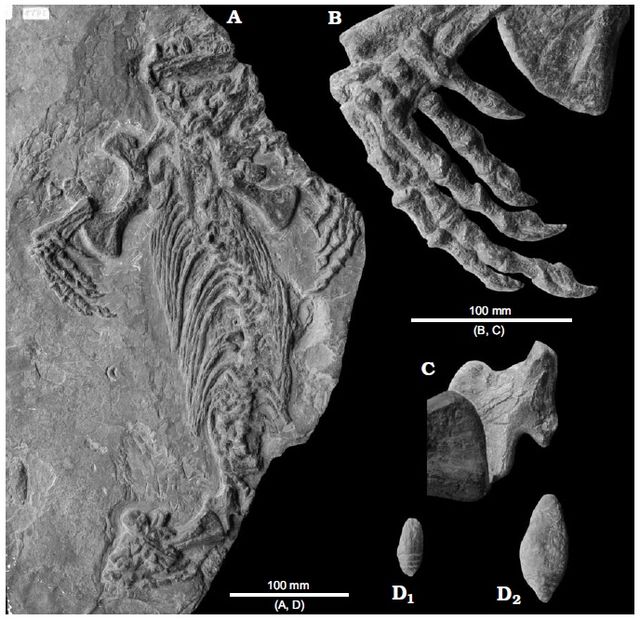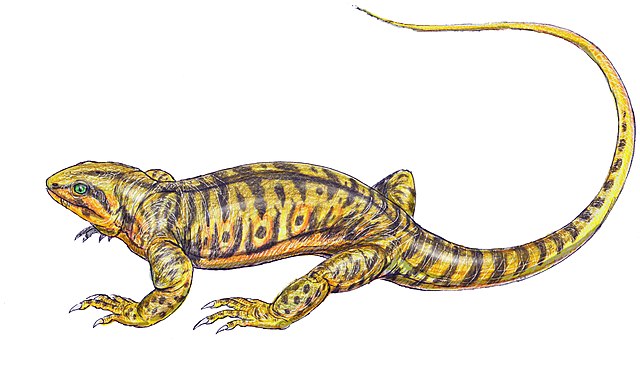Caseidae are an extinct family of basal synapsids that lived from the Late Carboniferous to Middle Permian between about 300 and 265 million years ago. Fossils of these animals come from the south-central part of the United States, from various parts of Europe, and possibly from South Africa if the genus Eunotosaurus is indeed a caseid as some authors proposed in 2021. Caseids show great taxonomic and morphological diversity. The most basal taxa were small insectivorous and omnivorous forms that lived mainly in the Upper Carboniferous and Lower Permian, such as Eocasea, Callibrachion, and Martensius. This type of caseid persists until the middle Permian with Phreatophasma and may be Eunotosaurus. During the early Permian, the clade is mainly represented by many species that adopted a herbivorous diet. Some have evolved into gigantic forms that can reach 6–7 metres (20–23 ft) in length, such as Cotylorhynchus hancocki and Alierasaurus ronchii, making them the largest Permian synapsids. Caseids are considered important components of early terrestrial ecosystems in vertebrate history because the numerous herbivorous species in this family are among the first terrestrial tetrapods to occupy the role of primary consumer. The caseids experienced a significant evolutionary radiation at the end of the early Permian, becoming, with the captorhinid eureptiles, the dominant herbivores of terrestrial ecosystems in place of the edaphosaurids and diadectids.

Caseidae
Skull of Euromycter rutenus in ventral view allowing to see the numerous small teeth adorning the bones of the palate (the parasphenoid, triangular in shape in the center, and the very elongated pterygoids on each side). The hyoid apparatus is not present here because it was removed during the preparation of the palate.
Skeleton of Cotylorhynchus romeri on display at the Sam Noble Oklahoma Museum of Natural History.
Holotype of the faunivorous caseid Callibrachion gaudryi preserved on the back (A). Detail of the right hand (B). Right ilium covered dorsally by the proximal end of the femur (C). Coprolites of sharks placed on the slab of the holotype during the 19th century (D).
Callibrachion is an extinct genus of caseid synapsids that lived in east-central France during the Lower Permian (Asselian). The holotype and only known specimen (MNHN.F.AUT490) is represented by an almost complete postcranial skeleton associated with skull fragments discovered at the end of the 19th century in the Permian Autun basin in Saône-et-Loire department, in the Bourgogne-Franche-Comté region. It belongs to an immature individual measuring less than 1.50 m in length. Callibrachion was long considered a junior synonym of the genus Haptodus and classified among the sphenacodontid pelycosaurs. In 2015, a new study found that Callibrachion was a different animal from Haptodus and that it was a caseasaur rather than a sphenacodontid. This was confirmed in 2016 by a cladistic analysis which recovered Callibrachion as a basal caseid. Callibrachion's sharp teeth and unenlarged ribcage indicate that this animal was likely faunivorous.
Callibrachion
Holotype of the Callibrachion gaudryi preserved on the back (A). Detail of the right hand (B). Right ilium covered dorsally by the proximal end of the femur (C). Coprolites of sharks placed on the slab of the holotype during the 19th century (D).
Explanatory drawing of the holotype of Callibrachion gaudryi.
Size comparison of basal caseasaurs including Callibrachion gaudryi.







